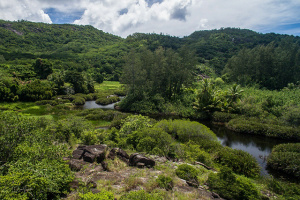Seychelles undertakes excercise to identify areas rich in biodiversity
General |Author: Sharon Ernesta | June 20, 2021, Sunday @ 15:07| 273500 views
Grand POlice on Mahe is one of the areas under consideration for the exercise. (Stan Adam)
Seychelles is undertaking an exercise to identify potential areas rich in biodiversity resulting in the expansion of marine and terrestrial protected areas of Seychelles’ Inner Islands.
The exercise being implemented under the Ridge to Reef R2R Project will be conducted at six Key Biodiversity Areas (KBA) in upland forest ecosystems which will result in newly created protected areas. The project is being implemented under the partnership of the Global Environment Fund (GEF) and the United Nations Development Programme (UNDP) coordinated by the government of Seychelles.
Joanna Prosper, the Reef Project Manager, told SNA that the main aim of the project is to strengthen the management capacity and assess the status for these areas.
Prosper added that the mapping exercise will be conducted at identified areas on the main island of Mahe, the second-most populated island of Praslin and Curieuse Island.
“The project seeks to amongst other activities undertake outreach with landowners with property within or immediately adjacent to the areas undertaking biodiversity assessments and habitat mapping as well as developing monitoring and management plans for each of these areas,” added Prosper.
The areas under consideration for the exercise are Montagne Planneau, Montagne Corrail – Collines du Sud and Grand Police, Montagne Brulee – Piton del’Eboulis, Praslin National Park extension, Riviere Kerlan and the western coast of Curieuse Island.
“These areas cover 2,235 ha of upland forest ecosystems, and the mapping exercise will be done with a focus on conserving biodiversity and carbon stocks,” said Prosper.
One of the consultants involved with the project, Elvina Henriette, said on Tuesday that these areas are potential sites for endemic plants and animals.
“KBAs have a lot of important functions from protecting the watersheds that provide us with potable water to providing a home for unique plants and animals found only in Seychelles. They are truly a great treasure to be secured for the next generations,” added Henriette.
Once completed, the exercise will provide the Ministry of Environment with much-needed data for future management of these areas or consideration for their status to be elevated to protected areas.
The project will also support the process to prepare the required documentation and recommendation for the legal gazetting of these areas which are under private ownership. In this regards the private landowners, as well as other partners, will be consulted during the exercise which will end in January 2022.
“The project will be exploring possible management structures for these sites and will consider piloting several different management approaches, including community management by private landowners and local community groups, or co-management with other partners such as the Seychelles National Parks Authority and not for profit organisations,” added Prosper.
According to the Manager, the project will pilot a new approach for Seychelles – 115 islands in the western Indian Ocean - for resolving issues related to private lands within protected areas.
In the end “help the government to determine a policy or process for putting private lands under varying forms of protection, as well as efforts to ensure that Key Biodiversity Areas are considered in government land use planning processes,” concluded Prosper.
Another consultant involved with this exercise said that the mapping will be accompanied by a series of awareness, sensitisation and educational activities.
Back
